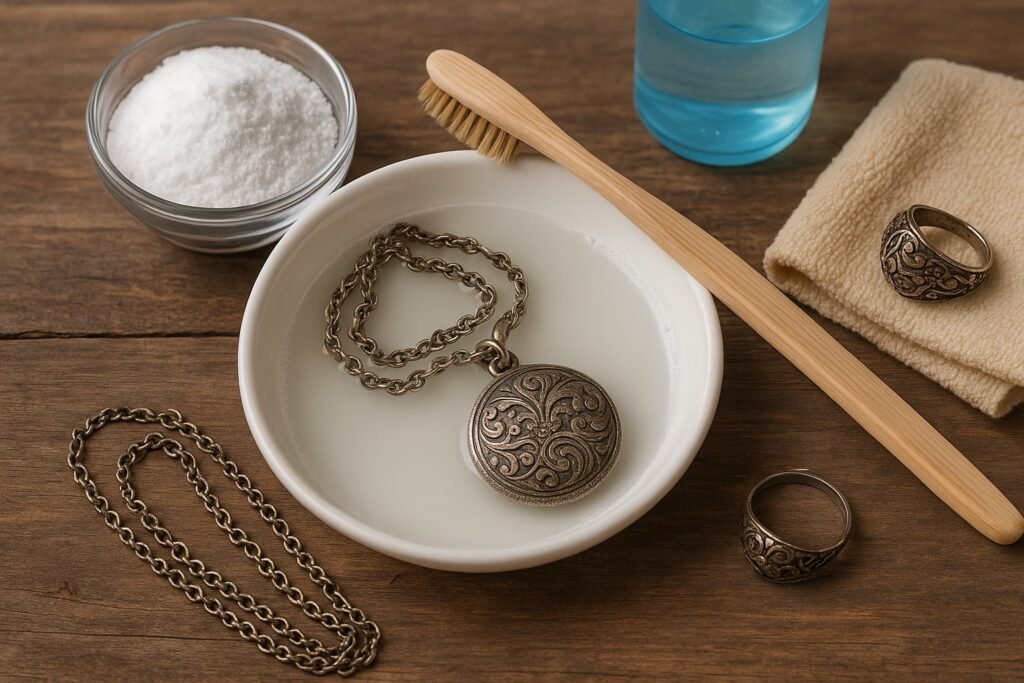If you’re wondering how to clean oxidised jewellery, you’re not alone. Many people find their once-sparkling accessories have dulled or turned black over time. Fortunately, restoring your jewellery’s original shine is easier than you might think—and you can do it at home using safe, household ingredients.
Oxidation is a natural reaction when jewellery, especially silver, comes into contact with air, moisture, or certain chemicals. Whether it’s tarnished bangles, darkened earrings, or oxidised necklaces, we’ve got you covered with foolproof cleaning techniques.

What Causes Jewellery to Oxidise?
Before diving into cleaning, it helps to understand what causes oxidation:
- Exposure to air and humidity
- Contact with lotions, perfumes, and sweat
- Improper storage without anti-tarnish strips
Oxidation doesn’t mean your jewellery is ruined. In fact, it can be reversed with a little effort.
Top Methods to Clean Oxidised Jewellery at Home
Here are some of the most effective methods to clean oxidised jewellery using items you probably already have.
1. Baking Soda and Water Paste
This method works well for silver and light oxidisation.
Steps:
- Mix 2 parts baking soda with 1 part water to form a thick paste.
- Gently rub it onto the jewellery using a soft toothbrush.
- Rinse with warm water and pat dry with a soft cloth.
✅ Safe for silver
✅ Non-abrasive
✅ Eco-friendly
2. Lemon Juice and Salt Soak
Lemon juice contains natural acids that help break down tarnish.
Steps:
- Mix 1 tablespoon of salt with half a cup of lemon juice.
- Soak the jewellery for 10–15 minutes.
- Rinse thoroughly and dry.
⚠️ Do not use on delicate stones or gold-plated items.
3. Toothpaste Cleaning
A mild, non-gel toothpaste can act as a gentle abrasive.
Steps:
- Apply a small amount of toothpaste with a soft brush.
- Gently scrub the jewellery.
- Rinse and buff dry.
Note: Avoid toothpaste with whitening agents or microbeads.
4. Aluminium Foil and Baking Soda Bath
This chemical reaction pulls the oxidation away from silver.
Steps:
- Line a bowl with aluminium foil (shiny side up).
- Add boiling water and a tablespoon of baking soda.
- Place jewellery in the bath for a few minutes.
- Rinse and dry.
🌟 Great for restoring multiple pieces quickly.
How to Prevent Oxidation
Once your jewellery is clean, take steps to prevent future tarnishing:
- Store pieces in airtight containers or zip-lock bags.
- Use anti-tarnish strips in your jewellery box.
- Remove jewellery before showering or applying lotions.
- Clean pieces regularly to avoid build-up.
Learn more care tips on our site: Jewellery Maintenance Guide
When to Avoid DIY Cleaning
DIY methods are effective for most oxidised pieces, but avoid them if:
- The item is antique or very valuable
- It has fragile or porous stones (like opal or turquoise)
- It’s gold-plated (abrasives can strip the layer)
In such cases, consider professional cleaning services or consult a jeweller.
Trusted Resources
For deeper insights into jewellery care, check out:
Conclusion
Knowing how to clean oxidised jewellery helps you maintain its beauty and value. Whether you use a baking soda paste or a lemon soak, regular maintenance and proper storage will keep your accessories sparkling. Try these tips today and bring your favourite pieces back to life!
FAQ: Clean Oxidised Jewellery
How often should I clean oxidised jewellery?
Ideally, clean your jewellery every 1–2 months or whenever you notice tarnishing.
Can I use vinegar to clean oxidised jewellery?
Yes, vinegar can be used, but dilute it and avoid using it on delicate stones.
Is it safe to clean oxidised jewellery with baking soda?
Yes, baking soda is safe for silver and non-plated metals. Always use a soft brush and avoid excessive scrubbing.

Leave a Reply